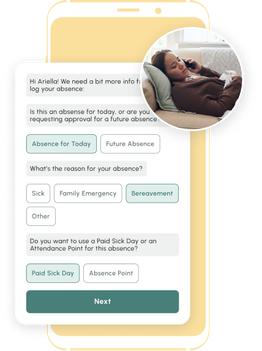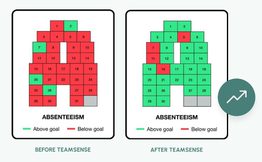Fix the root cause of No-Call No-Show with help from TeamSense
Table of Contents
- What Counts as Excessive Absenteeism? Definition + Examples
- Excused vs. Unexcused Absences
- How To Identify Excessive Absences in the Workplace
- Include Attendance Expectations in Your Employee Handbook
- How To Talk to Employees About Chronic Absenteeism
- 1. Clearly Communicate Attendance Policies and Absence Procedures
- 2. Show Employees You Care—Find Out Why They’re Absent
- 3. Address Attendance Issues In Real-Time
- 4. Apply the Rules Fairly to Everyone
- 5. Have Documentation That Backs You Up
- 6. Praise and Reward Good Attendance While Acknowledging Improvements
- Track Attendance With Text and Spot Excessive Absenteeism Fast
- How can I manage an employee with chronic health issues contributing to their absences?
- What should I do if the absenteeism is linked to workplace harassment or a hostile work environment?
- What are some potential legal issues when addressing excessive absenteeism?
- How do I handle a situation where the employee does not believe their absences are excessive?
- What if I suspect an employee is abusing sick leave?
- Can a high level of absenteeism indicate other problems within the organization?
Excessive absenteeism in the workplace is one of the biggest challenges for operations leaders, especially in frontline or shift-based businesses. From no-call no-shows to repeated tardiness, chronic absenteeism can derail productivity, lower morale, and hit your bottom line hard. In this post, we’ll define excessive absenteeism, explain how to handle it, and offer tools that help reduce unplanned absences in your organization.
On top of that, absenteeism can completely cripple large front-line business operations that depend on the manual labor or shift work done by hourly employees. According to the CDC, the productivity loss related to absenteeism costs employers $225.8 Billion each year, or $1,685 per employee.1
What Counts as Excessive Absenteeism? Definition + Examples
In its simplest definition, excessive absenteeism is when an employee is absent continuously. Over and over again. Without giving notice that they’ll be out. SHRM defines excessive absenteeism as “two or more occurrences of unexcused absence in a 30-day period.”2 That’s a valuable data point to use as a gauge for what counts as excessive absenteeism in the workplace.
Now, some amount of absenteeism is to be expected. That’s just the reality of operating a company with people. People get sick. People have doctor appointments. People take vacations. People have outside-of-work commitments that they need to keep. To expect every one of your team members to have perfect attendance is not realistic in any way, shape, or form.

No one wants to talk to their boss or a 1-800 stranger to call off. Text changes everything - Reducing No Call No Shows.
Excused vs. Unexcused Absences: Navigating the Attendance Spectrum
When it comes to employee attendance, understanding the distinction between excused and unexcused absences is crucial for both employers and employees. These two categories play a significant role in the management of attendance and the overall productivity of a workplace. In this blog post, we'll explore the key differences between excused and unexcused employee absences, and offer insights into how companies can manage them effectively.
Excused Absences: Permission Granted
Excused absences are those that are considered legitimate and acceptable reasons for an employee to miss work. They typically involve circumstances beyond an employee's control, such as illness, or family emergencies. In many organizations, employees are entitled to a certain number of excused absences, which may include paid time off (PTO) or sick leave. By providing valid documentation or advance notice, employees can usually secure approval for these absences without any negative repercussions.
Unexcused Absences: When No Excuse Suffices
On the other hand, unexcused absences occur when an employee misses work without a valid reason or without seeking prior approval from their supervisor or manager. These absences can lead to disciplinary actions, decreased productivity, and even job loss if they become a pattern. Examples of unexcused absences include skipping work without notice, taking an unplanned personal day, missing work without approval, or failing to provide adequate documentation for an absence.
Striking a Balance: Attendance Management Strategies
To maintain a productive and harmonious work environment, companies must establish clear attendance policies and guidelines that differentiate between excused and unexcused absences. This includes good attendance, outlining the acceptable reasons for excused absences, specifying the documentation required, and defining the consequences of unexcused absences.
By implementing a transparent and consistent attendance policy, companies can reduce the occurrence of unexcused absences and promote a more accountable workforce. Furthermore, using a modern attendance tracking solution like TeamSense, employers can simplify the process of managing and monitoring absences, allowing supervisors and HR managers to make informed decisions and maintain a strong digital connection with their frontline teams.
Is taking back-to-back Vacation and Sick Days Considered Excessive Absenteeism?
No, using vacation and sick days doesn’t usually fall into the “excessive absenteeism” category. That is, unless someone is thoroughly abusing their workplace or company’s vacation policy or sick leave.
From scheduled absences, like vacation days, to unscheduled absences, like sick days or family emergencies, there are times when workers have legitimate reasons to take time off of work. And that’s all part of what comes with running a business or an organization.
But team member absences become excessive when they fall above a normal level of absenteeism or become unreasonable. The definition of how many absences equals an excessive amount is up to you and your attendance policy.
How To Identify Excessive Absences in the Workplace
To figure out if an employee has a problem with excessive absences, you'll need to review his or her file and go over the recorded absences. According to the Academy to Innovate HR, 1.5% of aggregated absence is illness-related.3 That means that anything above that 1.5% threshold is usually because of non-illness-related reasons, such as personal issues or work conflicts.
To decide if the employee absences are unreasonable, you’ll need to base your decision on the underlying reason for the various absence rates, your company’s policies and procedures when it comes to time off, and the average level of absences expected in your industry or at your worksite. Of course, this is another reason why having an attendance policy at your company is essential.
Include Attendance Expectations in Your Employee Handbook
Don’t wait for chronic attendance issues to keep popping up before you address your workplace’s requirements and make your expectations for workers clear. Make sure these policies and procedures are known from the get-go. From day one on the job, employees should know your attendance policies and who to contact when they are absent.
Proactively improving your employee handbook and reminding most employees on your team of your policies can go a long way to help you avoid absenteeism and lost productivity. The handbook policies impacting absenteeism include time and attendance, disability accommodation, leaves of absence, ethical conduct, and disciplinary actions.
Speaking of your employee handbook, make sure it includes these things:
- Easy-to-understand language
- Text written in your workforce’s primary language
- Clarity on the procedures for handling absences
- Clear communication on expectations of disciplinary action
In addition to that, make sure reading and understanding the employee handbook is emphasized upfront as part of new hire onboarding and orientation. And, of course, always have your employee handbook looked at and approved by a labor attorney licensed to practice employment law in your state.
Employees should also receive occasional reminders about the policies and procedures and where to find them. Don’t make a practice out of forcing employees to sign acknowledgments of policies they’ve never seen or can’t access. Not only is it ineffective, but it can also create extra liability for your organization.
Once the handbook policies are explained to an employee, all employees should sign, acknowledge, and agree to the handbook policies.
How To Talk to Employees About Chronic Absenteeism
Once you’ve discovered the pattern of excessive employee absenteeism, it’s time to sit down and have a one-on-one conversation with the team member. But that’s easier said than done sometimes. The reality is, clearly communicating with an employee about their excessive absenteeism (and addressing the issue head-on) can be tricky. Here are six tips to help you talk about excessive employee absenteeism more with your employee.
1. Clearly Communicate Attendance Policies and Absence Procedures
With your attendance policy clearly laid out in your employee handbook, use that to help back you up as you talk with your employee about their excessive absenteeism.
Attendance and punctuality should always be listed as essential parts of each employee's job duties. Remind your team member of what was expected of them when they accepted this role. You can even point your employees back to the employee handbook they signed when they started with your company (which should have clearly covered absence and call-out expectations).
2. Show Employees You Care—Find Out Why They’re Absent
It’s easy to assume that every employee with attendance issues is either lazy or completely uninterested in their job. But there’s probably something else going on deeper than that. You’ll never know unless you ask. And guess what? The underlying cause matters.
Whether your employees are absent or tardy due to transportation issues, health issues, personal circumstances, or burnout, it’s essential to understand their barriers to success and find out why they are absent. Focusing on the symptoms of chronic absenteeism versus addressing the root cause can result in unnecessary turnover, additional costs, and wasted time on your part.
Listen and be empathetic, but take the opportunity to reinforce the expectations and requirements of the job. Reiterate how vital excellent employee attendance really is to your operations. Ask what you can do to support them and help them show up on time, as scheduled.
Before talking with the employee, check with your HR representative. There are questions you should and should not ask employees in different workplace circumstances, and it’s important to have HR looped in to avoid any potential bumps in the road.
3. Address Attendance Issues In Real-Time
Don’t wait to address attendance issues. Letting excessive absenteeism go on for months before you talk about it does a disservice to everyone involved. It’s like disciplining a child two weeks after they did something wrong. Delaying the discipline does no favors and just makes it worse when the hammer comes down.
If your company policy or employee handbook says that a warning is issued after three unexcused absences, then be prepared to follow through with those rules. It’s important that your team knows excessive absences will be handled in a way that lines up with the attendance policy with no surprises or special treatment.
4. Apply the Rules Fairly to Everyone
And speaking of special treatment, it’s key that your company applies the rules fairly to everyone—no matter who they are. You need to make sure no special treatment or favoritism is happening at your company. Upper management or entry-level employees—it makes no difference when it comes to enforcing the rules around excessive absenteeism.
Fair and consistent accountability is key to effectively enforcing your time and attendance policy, not to mention building respect from other employees on your team while inspiring integrity. When everything is laid out clearly, management is held accountable to follow through with the same kind of treatment for everyone.
5. Have Documentation That Backs You Up
Before you go and make accusations, be sure you have documentation to prove that the absent employee really did not report for work. A simple-to-use attendance management system is perfect for this and works far better than an Excel spreadsheet to prove your point.
The ruling in the court case of Williams v. AT&T Mobility Services LLC shows us the importance of demonstrating when an employee is unable to perform the essential job function of regular attendance and punctuality. In this case, a well-documented employee attendance points system prevented AT&T from having to accept an employee’s continued frequent absences and tardiness.4
The most reliable way to demonstrate patterns of policy violations is with an absence tracking system. TeamSense’s software allows your company to track and automatically keep documentation on unapproved or unexpected absences, for dispute resolution or audit purposes (if they pop up later on down the road).
6. Praise and Reward Good Attendance While Acknowledging Improvements
People love being rewarded for doing good things. Neuroscience research has shown that employees respond better to rewards and recognition than threats and punishment.5, 6 Instead of fearing the bad, or disciplinary action outcome, many employees are more inspired by positive reinforcement. That’s why it’s important to acknowledge when employees have improved their attendance and give public praise for achievements like no unexcused absences or perfect attendance.
And if you really want to motivate your team, make things competitive and add in prize rewards to promote excellent attendance. It doesn't have to be anything huge. A small cash bonus for perfect attendance for the quarter, a $25 gift card, or even free company swag can make all the difference to your team.
Track Attendance With Text and Spot Excessive Absenteeism Fast
In managing excessive absenteeism, the goal is not just about addressing the issue when it occurs but, more importantly, preventing it from becoming a recurring problem. And that's exactly where TeamSense comes in.
We've witnessed firsthand how our platform can help to significantly reduce instances of absenteeism, preventing the need for those difficult conversations. For example, in a case study, we just released, we detail our partnership with a major third-party logistics (3PL) company that operates 90 distribution centers. This company faced a consistent challenge of excessive absenteeism that they found difficult to manage.
By implementing TeamSense's text-based attendance management system, they saw a whopping 39% reduction in absenteeism. Unplanned absences dropped from an average of 64.1 hours per month to a much lower rate. This not only improved their overall productivity but also drastically cut down on the need for awkward and time-consuming discussions about excessive absenteeism.
So, instead of continually dealing with the consequences, why not get ahead of the issue? With TeamSense, you can proactively manage and drastically reduce absenteeism rates in your organization.
FAQs
How can I manage an employee with chronic health issues contributing to their absences?
It's essential to approach this situation with empathy and understanding. While maintaining business continuity, it's also crucial to respect an employee's health conditions. The first step is a constructive conversation where you can understand their health issue better. Consult with HR and consider possible accommodations that could be made under the Americans with Disabilities Act. It might be possible to offer flexible hours or allow work-from-home scenarios.
What should I do if the absenteeism is linked to workplace harassment or a hostile work environment?
If the underlying issue is a hostile work environment or harassment, the problem is much larger than absenteeism. Begin by addressing the immediate issue. You should thoroughly investigate any claims of harassment and take corrective action if necessary. Depending on the situation, you may need to involve HR, offer workplace training, or enforce stricter rules about behavior in the workplace.
What are some potential legal issues when addressing excessive absenteeism?
It's essential to approach excessive absenteeism carefully to avoid potential legal issues. For example, under the Family and Medical Leave Act (FMLA), eligible employees can take up to 12 weeks of unpaid, job-protected leave each year for some medical and family reasons. This leave may be intermittent FMLA and doesn't have to be taken in one sitting. Moreover, the Americans with Disabilities Act (ADA) may require employers to provide reasonable accommodations for employees with disabilities, which could include flexibility in attendance policies.
How do I handle a situation where the employee does not believe their absences are excessive?
In this case, it's crucial to have documentation of the absences and a clear attendance policy that defines what is considered excessive. During your discussion with the employee, explain your policy, provide evidence of their absences, and explain why their absences are impacting the team or company. It's important to remain objective and focus on the facts during these discussions.
What if I suspect an employee is abusing sick leave?
If you suspect an employee is abusing sick leave, it's essential to have a conversation with them first. Ask about their well-being and if there's anything they need support with. If the problem persists, consider requesting a medical certificate for absences. Be sure to follow your company's policies and any applicable labor laws when dealing with this issue.
Can a high level of absenteeism indicate other problems within the organization?
Yes, high absenteeism could be symptomatic of broader organizational issues, like low employee morale, poor management, or a toxic work culture. If you notice a high rate of absences, it might be worth investigating these possibilities. Anonymous surveys or a conversation with employees can provide valuable insights into these potential problems.

Boosting Efficiency: A 3PL Company Slashes Absenteeism by 39% with TeamSense
TeamSense changed the way this 3PL handled absenteeism, resulting in significant improvement in absenteeism rates, and can help your company too!
About the Author

Sheila Stafford, CEO of TeamSense & AI in HR Innovator
As CEO of TeamSense, Sheila Stafford is at the forefront of transforming HR for frontline teams through AI-driven solutions. With a commitment to enhancing employee relations and simplifying workforce management, Sheila leads TeamSense in pioneering advancements that empower both frontline employees and HR teams. Her visionary approach combines cutting-edge technology with a thoughtful focus on enhancing human connection; Sheila strategically implements AI where it adds the most value while recognizing the critical role of personal interaction and ensuring that human engagement remains central when it matters most. Under her leadership, TeamSense is redefining how companies support and engage their frontline teams for a more connected, efficient workplace.





